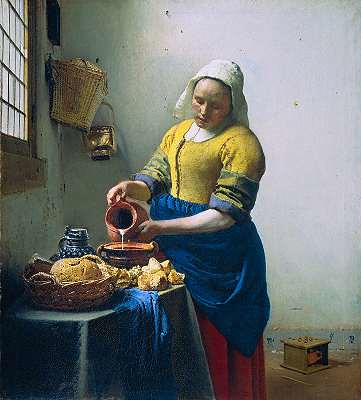History of baking
Middle ages
Baking was an extravagance few are able to afford. People who could afford a wood-burning stove and could heat it, would bake bread. The wealthier you were, the better the quality. Wealthy people ate fine floured wheat bread, baked goods were a lot more colourful . Less well off people ate rye and black bread and were lucky if they could afford meat for pie. Only the very wealthy could afford the types of cakes like what we have today although they were much heavier, weighing about 4.5 to 9kg.
15th century
A lot of expensive spices like saffron were introduced to Britain. Sweetened dough with lots of butter and cream was more expensive and only eaten by people who could afford it. The "wig" which was a small bun made with herbs, sweet dough and spices became popular. Mince pies were made with mutton or minced beef. Biscuits were rye based crisp breads.16th and 17th centuries
Different cultures began to be introduced along with their ingredients. Plump cake and bread textured dough with lots of butter, cream and raisins became popular. Economies grew so middle class people started baking things other then bread.Baking became more accessible so way more people baked cakes and biscuits. By the late 17th century sugar was quite cheap mince pies as we think of them today that are made with spices and sugar were invented.Small cakes and buns were eaten as part of the dessert. Kitchen equipment like the cake hoop (a cake tin) tins were lined with buttered paper.
Pastries were fashionable in the late 17th century. Pastry making was a skill all good housewives were believed to have. London cookery schools taught pastry-making.
18th century
Cake making became popular but the industrial revolution saw a return to heavier, dull baked goods. Working class eat bread and jam.At Easter and Christmas and other occasions a rich diet would be eaten by even the poorer members of society. Shopkeepers could afford ovens therefore they could bake.
19th century
Popularity of convinience food grew. Cakes became lighter with the introduction of baking powder. More working class women became employed in the 19th century and there was less time for time consuming food preparation. Fast Food is usually thought of as being a fairly recent thing but women in Britain in the 19th century relied on convenience food like pies. Baking powder changed the style of cakes change from dense cakes into cakes made with flour, fat, eggs and a raising agent. |
| https://www.flickr.com/photos/jimmiehomeschoolmom/3406664666 Sources:http://www.historyextra.com/feature/brief-history-baking |
No comments:
Post a Comment